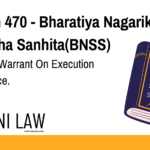Code
(1) Where a person has, during the period of investigation, inquiry or trial under
this Sanhita of an offence under any law (not being an offence for which the punishment of
death or life imprisonment has been specified as one of the punishments under that law)
undergone detention for a period extending up to one-half of the maximum period of
imprisonment specified for that offence under that law, he shall be released by the Court on
bail:
Provided that where such person is a first-time offender (who has never been convicted
of any offence in the past) he shall be released on bond by the Court, if he has undergone
detention for the period extending up to one-third of the maximum period of imprisonment
specified for such offence under that law:
Provided further that the Court may, after hearing the Public Prosecutor and for
reasons to be recorded by it in writing, order the continued detention of such person for a
period longer than one-half of the said period or release him on bail bond instead of his
bond:
Provided also that no such person shall in any case be detained during the period of
investigation, inquiry or trial for more than the maximum period of imprisonment provided
for the said offence under that law.
Explanation.—In computing the period of detention under this section for granting
bail, the period of detention passed due to delay in proceeding caused by the accused shall
be excluded.
(2) Notwithstanding anything in sub-section (1), and subject to the third proviso
thereof, where an investigation, inquiry or trial in more than one offence or in multiple cases
are pending against a person, he shall not be released on bail by the Court.
(3) The Superintendent of jail, where the accused person is detained, on completion
of one-half or one-third of the period mentioned in sub-section (1), as the case may be, shall
forthwith make an application in writing to the Court to proceed under sub-section (1) for
the release of such person on bail.
Explanation of Section 479 BNSS
Section 479 BNSS aims to protect under-trial prisoners from being detained indefinitely by setting a maximum period of detention. It ensures that:
- Bail is Mandatory – If an under-trial prisoner has been detained for more than half of the maximum sentence prescribed for the offence, they are entitled to bail.
- Special Consideration for First-Time Offenders – If the accused has never been convicted before, they can be released on bond after serving one-third of the maximum prescribed sentence.
- Judicial Discretion – The Court can extend detention beyond the halfway mark after hearing the Public Prosecutor and recording reasons in writing.
- Absolute Limit on Detention – Under no circumstances can a prisoner be detained for more than the maximum punishment prescribed for the offence.
- Multiple Cases Exception – If an accused is facing multiple charges, this provision does not apply, and the Court has discretion over bail decisions.
- Jail Authority’s Responsibility – The jail superintendent is legally bound to inform the Court when an under-trial has completed half or one-third of their potential sentence to initiate bail proceedings.
Illustrations
Example 1: Theft Case
A person is accused of theft under Section 304 BNSS, which carries a maximum imprisonment term of 3 years. The accused has already spent 1.5 years (half the sentence) in jail without conviction. Under Section 479 BNSS, the Court must grant bail.
Example 2: First-Time Offender
A student accused of a minor fraud offence with a maximum sentence of 2 years has already spent 8 months in jail. Since they have no prior convictions, the Court must release them on a bond (not bail) after serving one-third (8 months) of their maximum sentence.
Example 3: Multiple Pending Cases
A businessman accused of fraud and tax evasion is under trial in two separate cases. Even if he has spent half of the sentence in detention for one case, he is not eligible for bail under Section 479 BNSS, as trials for multiple offences are still ongoing.
Common Questions and Answers on Section 479 BNSS
1. Can an under-trial prisoner be detained indefinitely?
No, Section 479 BNSS ensures that no accused is detained beyond the maximum period prescribed for the offence.
2. What is the difference between bail and bond under this section?
- Bail: Given when the accused has served half of the maximum sentence.
- Bond: Given to first-time offenders after serving one-third of the maximum sentence.
3. What happens if the Court delays proceedings intentionally or due to external reasons?
If the delay is caused by the accused, that period is excluded from the detention calculation. However, if the delay is due to the Court, the accused is entitled to bail.
4. Can the Court refuse bail even after an under-trial has served half the sentence?
Yes, but only if the Public Prosecutor argues against bail and the Court records specific reasons for continued detention in writing.
5. Who is responsible for notifying the Court when an under-trial qualifies for release?
The Superintendent of Jail must inform the Court when an under-trial has completed half (or one-third for first-time offenders) of the maximum imprisonment period.
Conclusion
Section 479 BNSS is a safeguard against prolonged detention of under-trial prisoners and ensures that their right to liberty is not violated due to judicial delays. It strikes a balance between justice and fairness by allowing bail at appropriate stages while permitting continued detention only under exceptional circumstances.
For more legal insights, visit ApniLaw 🚀








